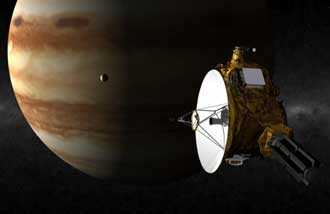Sun, Jul 15, 2012
Will Assist In Navigation Of New Horizons Spacecraft Through The Dwarf Planet's Orbit
A team of astronomers using NASA’s Hubble Space Telescope is reporting the discovery of another moon orbiting the icy dwarf planet Pluto.

The moon is estimated to be irregular in shape and 6 to 15 miles across. It is in a 58,000-mile-diameter circular orbit around Pluto that is assumed to be co-planar with the other satellites in the system. “The moons form a series of neatly nested orbits, a bit like Russian dolls,” said team lead Mark Showalter of the SETI Institute in Mountain View, CA.
The discovery increases the number of known moons orbiting Pluto to five.
The Pluto team is intrigued that such a small planet can have such a complex collection of satellites. The new discovery provides additional clues for unraveling how the Pluto system formed and evolved. The favored theory is that all the moons are relics of a collision between Pluto and another large Kuiper belt object billions of years ago. The new detection will help scientists navigate NASA’s New Horizons spacecraft through the Pluto system in 2015, when it makes an historic and long-awaited high-speed flyby of the distant world.
The team is using Hubble’s powerful vision to scour the Pluto system to uncover potential hazards to the New Horizons spacecraft. Moving past the dwarf planet at a speed of 30,000 miles per hour, New Horizons could be destroyed in a collision with even a BB-shot-size piece of orbital debris. “The discovery of so many small moons indirectly tells us that there must be lots of small particles lurking unseen in the Pluto system,” said Harold Weaver of the Johns Hopkins University Applied Physics Laboratory in Laurel, MD. “The inventory of the Pluto system we're taking now with Hubble will help the New Horizons team design a safer trajectory for the spacecraft,” added Alan Stern of the Southwest Research Institute in Boulder, Colo., the mission’s principal investigator.

Pluto’s largest moon, Charon, was discovered in 1978 in observations made at the United States Naval Observatory in Washington, D.C. Hubble observations in 2006 uncovered two additional small moons, Nix and Hydra. In 2011 another moon, P4, was found in Hubble data.
Provisionally designated S/2012 (134340) 1, the latest moon was detected in nine separate sets of images taken by Hubble’s Wide Field Camera 3 on June 26, 27, 29, and July 7 and 9.
In the years following the New Horizons Pluto flyby, astronomers plan to use the infrared vision of Hubble’s planned successor, NASA’s James Webb Space Telescope, for follow-up observations. The Webb telescope will be able to measure the surface chemistry of Pluto, its moons, and many other bodies that lie in the distant Kuiper Belt along with Pluto.
(Images provided by NASA)
More News
How To Get A Story On Aero-TV News/Feature Programming How do I submit a story idea or lead to Aero-TV? If you would like to submit a story idea or lead, please contact Jim Campbel>[...]
From 2011 (YouTube Edition): Aviation's Greatest Living Legend Talks About His Life In Aviation (Part 5, Final) ANN is pleased to offer you yet another snippet from the public conv>[...]
“All Air Traffic Controllers must get back to work, NOW!!! Anyone who doesn’t will be substantially ‘docked. For those Air Traffic Controllers who were GREAT PATR>[...]
Aero Linx: American Navion Society Welcome to the American Navion Society. Your society is here to support the Navion community. We are your source of technical and operating infor>[...]
Glideslope Intercept Altitude The published minimum altitude to intercept the glideslope in the intermediate segment of an instrument approach. Government charts use the lightning >[...]
 ANN FAQ: Contributing To Aero-TV
ANN FAQ: Contributing To Aero-TV Classic Aero-TV: Bob Hoover At Airventure -- Flight Test and Military Service
Classic Aero-TV: Bob Hoover At Airventure -- Flight Test and Military Service Aero-News: Quote of the Day (11.12.25)
Aero-News: Quote of the Day (11.12.25) ANN's Daily Aero-Linx (11.12.25)
ANN's Daily Aero-Linx (11.12.25) ANN's Daily Aero-Term (11.12.25): Glideslope Intercept Altitude
ANN's Daily Aero-Term (11.12.25): Glideslope Intercept Altitude




